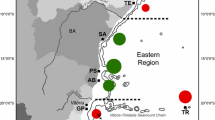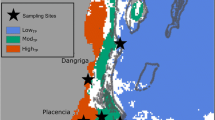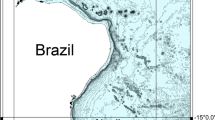Abstract
The relative abundance of the genus Siderastrea and its relationship with temperature and irradiance was assessed around Sal Island (Cape Verde). In some of the surveyed sites, these corals accounted for 80–90 % of the living cover, making it a biotope-dominant organism. Unlike Siderastrea corals from West Atlantic and Caribbean locations, genetic analyses of the dinoflagellate symbiotic partner revealed high specificity between Siderastrea sp. in Cape Verde and the Symbiodinium type C46. Biotope restriction of the ecological success of Siderastrea in Cape Verde may be explained in part by this host–symbiont partnership, resulting locally in a small optimum ecological niche with specific light intensity regimes. Distinctively, West Atlantic and Caribbean Siderastrea associates with a much broader range of Symbiodinium diversity, suggesting that these symbioses exhibit some flexibility under differing environmental conditions where these corals occupy a wider range of ecological niches. Geographic isolation and/or long-standing environmental conditions are probably responsible for such adaptions and coral–dinoflagellate symbioses. Additional genetic analyses on Clade C Symbiodinium associated with Siderastrea were conducted with the hyper-variable plastid psbA minicircle to resolve phylogeographic patterns that indicate the relative connectivity and/or isolation of these symbionts throughout the tropical Atlantic.







Similar content being viewed by others
References
Acker J, Leptoukh G (2007) Online analysis enhances use of NASA earth science data. Eos Trans Am Geophys Union 88:14–17
Avise JC, Wollenberg K (1997) Phylogenetics and the origin of species. Proc Natl Acad Sci USA 94:7748–7755
Baillie B, Belda-Baillie C, Silvestre V, Sison M, Gomez AV, Gomez ED, Monje V (2000) Genetic variation in Symbiodinium isolates from giant clams based on random-amplified-polymorphic DNA (RAPD) patterns. Mar Biol 136:829–836
Baker AC, Starger CJ, McClanahan TR, Glynn PW (2004) Coral reefs: corals' adaptive response to climate change. Nature 430:741
Barbrook A, Visram S, Douglas A, Howe C (2006) Molecular diversity of dinoflagellate symbionts of cnidaria: the psbA minicircle of Symbiodinium. Protist 157:159–171
Berkelmans R, van Oppen MJH (2006) The role of zooxanthellae in the thermal tolerance of corals: a “nugget of hope” for coral reefs in an era of climate change. Proc R Soc Lond B 273:2305–2312
Bohren CF, Huffmann DR (1983) Absorption and scattering of light by small particles. Wiley, New York
Bongaerts P, Riginos C, Ridgway T, Sampayo EM, van Oppen MJH, Englebert N, Vermeulen F, Hoegh-Guldberg O (2010) Genetic Divergence across Habitats in the Widespread Coral Seriatopora hystrix and Its Associated Symbiodinium. PLoS ONE 5:e10871
Braby H (1913) The Harmattan wind of the Guinea Coast. Q J R Meteorol Soc 39:301–306
Castillo KD, Ries JB, Weiss JM (2011) Declining coral skeletal extension for forereef colonies of Siderastrea siderea on the Mesoamerican Barrier Reef System, Southern Belize. PLoS ONE 6:e14615
Colombo-Pallotta MF, Rodríguez-Román A, Iglesias-Prieto R (2010) Calcification in bleached and unbleached Montastraea faveolata: evaluating the role of oxygen and glycerol. Coral Reefs 29:899–907
Costa CF, Sassi R, Gorlach-Lira K (2008) Zooxanthellae genotypes in the coral Siderastrea stellata from coastal reefs in northeastern Brazil. J Exp Mar Biol Ecol 367:149–152
Finney JC, Pettay DT, Sampayo EM, Warner ME, Oxenford HA, LaJeunesse TC (2010) The relative significance of host–habitat, depth, and geography on the ecology, endemism, and speciation of coral endosymbionts in the genus Symbiodinium. Microb Ecol 60:250–263
Fitt W, Brown B, Warner M, Dunne R (2001) Coral bleaching: interpretation of thermal tolerance limits and thermal thresholds in tropical corals. Coral Reefs 20:51–65
Floeter SR, Rocha LA, Robertson DR, Joyeux JC, Smith-Vaniz WF, Wirtz P, Edwards AJ, Barreiros JP, Ferreira CEL, Gasparini JL, Brito A, Falcón JM, Bowen BW, Bernardi G (2007) Atlantic reef fish biogeography and evolution. J Biogeogr 35:22–47
Foster AB (1980) Environmental variation in skeletal morphology within the Caribbean Reef Corals Montastraea annularis and Siderastrea siderea. Bull Mar Sci 30:678–709
Garrison VH, Shinn EA, Foreman WT, Griffin DW, Holmes CW, Kellogg CA, Majewski MS, Richardson LL, Ritchie KB, Smith GW (2003) African and Asian dust: from desert soils to coral reefs. Bioscience 53:469–480
Gill JA, Watkinson AR, McWilliams JP, Cote IM (2006) Opposing forces of aerosol cooling and El Nino drive coral bleaching on Caribbean reefs. Proc Natl Acad Sci USA 103:18870–18873
Goulet T, LaJeunesse TC, Fabricius K (2008) Symbiont specificity and bleaching susceptibility among soft corals in the 1998 Great Barrier Reef mass coral bleaching event. Mar Biol 154:795–804
Griffin D, Garrison V, Herman J, Shinn E (2001) African desert dust in the Caribbean atmosphere: microbiology and public health. Aerobiologia 17:203–213
Hallock P (1981) Algal symbiosis: a mathematical analysis. Mar Biol 62:249–255
Hoegh-Guldberg O (2004) Coral reefs in a century of rapid environmental change. Symbiosis 37:1–31
Hoeksema BW, Roos PJ, Cadée GC (2012) Trans-Atlantic rafting by the brooding reef coral Favia fragum on man-made flotsam. Mar Ecol Prog Ser 445:209–218
Iglesias-Prieto R, Trench R (1994) Acclimation and adaptation to irradiance in symbiotic dinoflagellates. I. Responses of the photosynthetic unit to changes in photon flux density. Mar Ecol Prog Ser 113:163–175
Iglesias-Prieto R, Beltrán VH, LaJeunesse TC, Reyes-Bonilla H, Thomé PE (2004) Different algal symbionts explain the vertical distribution of dominant reef corals in the eastern Pacific. Proc R Soc Lond B 271:1757–1763
Kemp D, Cook C, LaJeunesse TC, Brooks W (2006) A comparison of the thermal bleaching responses of the zoanthid Palythoa caribaeorum from three geographically different regions in south Florida. J Exp Mar Biol Ecol 335:266–276
Kohler K, Gill S (2006) Coral Point Count with Excel extensions (CPCe): a visual basic program for the determination of coral and substrate coverage using random point count methodology. Comput Geosci 32:1259–1269
Laborel J (1974) West African Reef Corals, an hypothesis on their origin. Proc 2nd Int Coral Reef Symp 1:425–443
LaJeunesse TC (2001) Investigating the biodiversity, ecology, and phylogeny of endosymbiotic dinoflagellates in the genus Symbiodinium using the ITS region: in search of a“species” level marker. J Phycol 37:866–880
LaJeunesse TC (2002) Diversity and community structure of symbiotic dinoflagellates from Caribbean coral reefs. Mar Biol 141:387–400
LaJeunesse TC (2005) “‘Species’” radiations of symbiotic dinoflagellates in the Atlantic and Indo-Pacific since the Miocene-Pliocene transition. Mol Biol Evol 22:570–581
LaJeunesse TC, Thornhill DJ (2011) Improved resolution of reef-coral endosymbiont (Symbiodinium) species diversity, ecology, and evolution through psbA non-coding region genotyping. PLoS ONE 6:e29013
LaJeunesse TC, Loh WKW, van Woesik R, Hoegh-Guldberg O (2003) Low symbiont diversity in Southern Great Barrier Reef Corals, relative to those of the Caribbean. Limnol Oceanogr 48:2046–2054
LaJeunesse TC, Bhagooli R, Hidaka M, de Vantier L, Done T, Schmidt GW, Fitt WK, Hoegh-Guldberg O (2004a) Closely related Symbiodinium spp. differ in relative dominance in coral reef host communities across environmental, latitudinal and biogeographic gradients. Mar Ecol Prog Ser 284:147–161
LaJeunesse TC, Thornhill DJ, Cox EF, Stanton FG, Fitt WK, Schmidt GW (2004b) High diversity and host specificity observed among symbiotic dinoflagellates in reef coral communities from Hawaii. Coral Reefs 23:596–603
LaJeunesse TC, Pettay D, Sampayo EM, Phongsuwan N, Brown B, Obura DO, Hoegh-Guldberg O, Fitt WK (2010) Long-standing environmental conditions, geographic isolation and host–symbiont specificity influence the relative ecological dominance and genetic diversification of coral endosymbionts in the genus Symbiodinium. J Biogeogr 37:785–800
Lewis J (1989) Spherical growth in the Caribbean coral Siderastrea radians (Pallas) and its survival in disturbed habitats. Coral Reefs 7:161–167
Li X, Maring H, Savoie D, Voss K (1996) Dominance of mineral dust in aerosol light-scattering in the North Atlantic trade winds. Nature 380:416–419
Lirman D, Manzello D (2009) Patterns of resistance and resilience of the stress-tolerant coral Siderastrea radians (Pallas) to sub-optimal salinity and sediment burial. J Exp Mar Biol Ecol 369:72–77
Lirman D, Manzello D, Maciá S (2002) Back from the dead: the resilience of Siderastrea radians to severe stress. Coral Reefs 21:291–292
Littman RA, van Oppen MJH, Willis BL (2008) Methods for sampling free-living Symbiodinium (zooxanthellae) and their distribution and abundance at Lizard Island (Great Barrier Reef). J Exp Mar Biol Ecol 364:48–53
Monteiro P, Ribeiro D, Silva JA, Bispo J, Gonçalves J (2008) Ichthyofauna assemblages from two unexplored Atlantic seamounts: Northwest Bank and João Valente Bank (Cape Verde Archipelago). Sci Mar 72:133–143
Monteiro J, Almeida C, Freitas R, Delgado A, Porteiro F, Santos RSS (2009) Coral assemblages of Cape Verde: preliminary assessment and description. Proc 11th Int Coral Reef Symp 2:1416–1419
Moore RB, Ferguson KM, Loh WKW, Hoegh-Guldberg O, Carter D (2003) Highly organized structure in the non-coding region of the psbA minicircle from clade C Symbiodinium. Int J Syst Evol Microbiol 53:1725–1734
Morri C, Bianchi C (1995) Cnidarian Zonation at Ilha do Sal (Arquipélago de Cape Verde). Beitr Paläontol 20:41–49
Moses C, Helmle K, Swart P, Dodge E, Merino SE (2003) Pavements of Siderastrea radians on Cape Verde reefs. Coral Reefs 22:506. doi:10.1007/s00338-003-0346-x
Muller-Parker G, D'Elia C (1997) Interactions between corals and their symbiotic algae. In: Birkeland C (ed) Life and death of coral reefs. Chapman and Hall, New York, pp 96–113
Muscatine L, McCloskey L, Marian R (1981) Estimating the daily contribution of carbon from zooxanthellae to coral animal respiration. Limnol Oceanogr 26:601–611
Neves E, Andrade S, Silveira F, Solferini V (2008) Genetic variation and population structuring in two brooding coral species (Siderastrea stellata and Siderastrea radians) from Brazil. Genetica 132:243–254
Nunes F, Norris RD, Knowlton D (2011) long distance dispersal and connectivity in Amphi-Atlantic Corals at regional and basin scales. PLoS ONE 6:e22298
Oigman-Pszczol S, Creed J (2004) Size structure and spatial distribution of the corals Mussismilia hispida and Siderastrea stellata (Scleractinia) at Armação dos Búzios, Brazil. Bull Mar Sci 74:433–448
Oliver TA, Palumbi SR (2010) Many corals host thermally resistant symbionts in high-temperature habitat. Coral Reefs 30:241–250
Pearse VB, Muscatine L (1971) Role of symbiotic algae (Zooxanthellae) in coral calcification. Biol Bull 141:350–363
Pochon X, LaJeunesse TC, Pawlowski J (2004) Biogeographic partitioning and host specialization among foraminiferan dinoflagellate symbionts (Symbiodinium; Dinophyta). Mar Biol 146:17–27
Pochon X, Stat M, Takabayashi M, Chasqui L, Chauka LJ, Logan DDK, Gates RD (2010) Comparison of endosymbiotic and free-living Symbiodinium (dinophyceae) diversity in a Hawaiian reef environment. J Phycol 46:53–65
Rocha LA, Rocha CR, Robertson DR, Bowen BW (2008) Comparative phylogeography of Atlantic reef fishes indicates both origin and accumulation of diversity in the Caribbean. BMC Evol Biol 8:157–173
Rodriguez-Lanetty M, Krupp DA, Weis VM (2004) Distinct ITS types of Symbiodinium in Clade C correlate with cnidarian/dinoflagellate specificity during onset of symbiosis. Mar Ecol Prog Ser 275:97–102
Rowan R, Knowlton N, Baker A, Jara J (1997) Landscape ecology of algal symbionts creates variation in episodes of coral bleaching. Nature 388:265–269
Sampayo E, Franceschinis L, Hoegh-Guldberg O, Dove S (2007) Niche partitioning of closely related symbiotic dinoflagellates. Mol Ecol 16:3721–3733
Sampayo E, Dove S, LaJeunesse TC (2009) Cohesive molecular genetic data delineate species diversity in the dinoflagellate genus Symbiodinium. Mol Ecol 18:500–519
Seutin G, White BN, Boag PT (1991) Preservation of avian blood and tissue samples for DNA analyses. Can J Zool 69:82–90
Shinn E, Smith G, Prospero J, Betzer P (2000) African dust and the demise of Caribbean Coral Reefs. Geophys Res Lett 27:3029–3032
Stanley GD Jr (2006) Photosymbiosis and the evolution of modern coral reefs. Science 312:857–858
Stat M, Carter D, Hoegh-Guldberg O (2006) The evolutionary history of Symbiodinium and scleractinian hosts - Symbiosis, diversity, and the effect of climate change. Perspect Plant Ecol Evol Syst 8:23–43
Swofford D (2000) PAUP*, Phylogenetic analysis using parsimony (*and other methods). Sinauer, Sunderland
Thornhill DJ, Fitt WK, Schmidt GW (2006a) Highly stable symbioses among western Atlantic brooding corals. Coral Reefs 25:515–519
Thornhill DJ, LaJeunesse TC, Kemp DW, Fitt WK, Schmidt GW (2006b) Multi-year, seasonal genotypic surveys of coral-algal symbioses reveal prevalent stability or post-bleaching reversion. Mar Biol 148:711–722
Trench R (1993) Microalgal-invertebrate symbioses-a review. Endocytob Cell Res 9:135–175
Veron JEN, Stafford-Smith M (2000) Corals of the world. 1:490. Australian Institute of Marine Science, Townsville
Veron JEN, Stafford-Smith M (2002) Coral ID (CD-Rom, first release). Australian Institute of Marine Science, Townsville
Wallenstein FFMM, Neto AI, Álvaro NV, Tittley I (2008) Subtidal rocky shore communities of the Azores: developing a biotope survey method. J Coast Res 24:244–249
Warner ME, LaJeunesse TC, Robison JD, Thur RM (2006) The ecological distribution and comparative photobiology of symbiotic dinoflagellates from reef corals in Belize: potential implications for coral bleaching. Limnol Oceanogr 52:1887–1897
Wilke B, Duke B, Jimoh W (1984) Mineralogy and chemistry of Harmattan dust in northern Nigeria. Catena 11:91–96
Zazo C, Goy J, Dabrio CJ, Soler V, Hillaire-Marcel C, Ghaleb B, González-Delgado JA, Bardají T, Cabero A (2007) Quaternary marine terraces on Sal Island (Cape Verde archipelago). Quat Sci Rev 26:876–893
Acknowledgements
We wish to thank Cape Verde Diving, Dunas de Sal and Scuba Caribe dive operators who provided help and logistic support to all fieldwork in Cape Verde. We thank the Brazilian students Tatiana P. de Leon Amorim and Carolina da Rocha Simões for help with collections and processing of samples. D. Thornhill provided several psbA sequences from colonies of Siderastrea monitored near Lee Stocking Island, Bahamas. We also thank all reviewers for their comments and contributions. This research was also part of J.M.’s doctoral research program (SFRH/BD/27869/2009), funded by the Portuguese Foundation for Science and Technology (FCT). Funding for this research was also provided by the IOC-UNESCO-World Bank Targeted working group on coral bleaching and Pennsylvania State University. IMAR-DOP/UAz (Research and Development Unit no. 531) and LarSyS-Associated Laboratory are supported by the Portuguese Foundation for Science and Technology (FCT) under a strategic project and DRCTC-GR Azores through a Pluriannual Funding scheme (COMPETE and PRO-Convergência). Exchange of specimens was made possible by a Material Transfer Agreement between Penn State University and the Universidade Federal da Paraiba and by CITES permit 02/2008 issued by Direcção Geral do Ambiente, Cape Verde.
Author information
Authors and Affiliations
Corresponding author
Rights and permissions
About this article
Cite this article
Monteiro, J.G., Costa, C.F., Gorlach-Lira, K. et al. Ecological and biogeographic implications of Siderastrea symbiotic relationship with Symbiodinium sp. C46 in Sal Island (Cape Verde, East Atlantic Ocean). Mar Biodiv 43, 261–272 (2013). https://doi.org/10.1007/s12526-013-0153-8
Received:
Revised:
Accepted:
Published:
Issue Date:
DOI: https://doi.org/10.1007/s12526-013-0153-8




